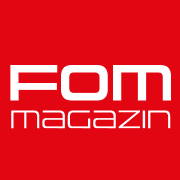Remote workers complain about their disadvantage in hybrid meetings. It's hard for them to get a word in edgewise and they can't really contribute. With clear structures, companies can create an efficient meeting experience even in the home office.
An Editorial of the FOM Magazine
Get up, have coffee, breakfast and then get to your desk. The workday in the home office begins without a commute, traffic jams or crowded subways. A brave new world of work! Digitization and remote working make it possible.But the everyday life of remote workers in the home office is not quite so carefree. Especially not the meetings. Remote workers are increasingly finding that their voices are not heard as much in hybrid meetings as they are in face-to-face meetings.
Home office disadvantages in hybrid meetings
According to a study by Barco, a provider of collaboration solutions, two-thirds of the 4,000 workers surveyed worldwide say they find hybrid meetings stressful.
The criticism relates to both technology and emotional issues. The central criticism is that remote participants feel overlooked:
- Fifty-six percent say meeting leaders focus too much on on-site participants in leading the conversation .
- 35 percent say they can't fully engage in hybrid meetings.
- 28 percent say they have difficulty making themselves heard in the group.
- 31 percent say they cannot read the body language and nonverbal signals of other meeting participants.
In terms of technical difficulties, the following are the main problems: - 62 percent say they can't hear other meeting participants well.
- 58 percent find it challenging to share content.
- 48 percent report difficulty linking video and audio.
Despite the criticisms of hybrid meetings, 80 percent of employees say they still prefer remote work over office presence.
Still, executives need to ask themselves how they can make hybrid meetings more efficient.
Structure improves online meeting experience in hybrid meetings
The respondents of the study already provide the answer to this question: 30 percent of the respondents would consider a job offer from another company if they had established clear guidelines and tools for hybrid meetings.
So the solution lies in the right meeting structure: every meeting needs clear rules and tools to enable their implementation. In other words, companies need FOMs!
Remote employees in the home office benefit in FOMs in particular from a regulated discussion structure.
- An interactive agenda sets the course of the conversation.
- Requests to speak are registered by a show of hands or a button - regardless of whether one participates in the meeting as a presence or remote participant.
- Group decisions are made with digital voting tools , anonymously if necessary.
- Chat tools allow questions to be submitted. This is particularly advantageous for meetings with a large number of participants.
- Screen sharing and the integration of third-party tools such as MS Office or Zoom make it easy to share content.
Using specialized FOM software removes barriers to access for remote workers and ensures a fair and inclusive conversation. This allows all participants to engage in the same way, regardless of location.
Efficient online meetings are not just a question of employee satisfaction
Nevertheless, hybrid meetings have certain disadvantages. For example, it is true that body language and nonverbal signals are not transmitted to the same extent as in face-to-face meetings.
In the future, nonverbal communication could be better represented, for example, by meetings in the metaverse. At present, however, this is pie in the sky.
On the other hand, hybrid meetings have many advantages: If participants are unable to attend, they can dial in online at short notice. The elimination of travel reduces costs and the carbon footprint of meetings. In addition, meetings can be organized more quickly and easily.
A return to the culture of presence is therefore not the solution. Instead, it's about creating a level playing field for remote and face-to-face employees.
It seems that companies are slowly realizing this: 60 percent of the companies participating in the survey have not yet established formal guidelines for hybrid meetings. Conversely, this also means that 40 percent are already addressing the issue.
By the way, it's not "just" about employee satisfaction.
Even a small company with just 100 employees
loses more than a million euros every year due to unproductive meetings.
So it's also about the return on investment of the meetings.
Because that's exactly what every meeting is: an investment!
Write to us at contact@fom-magazin.de





